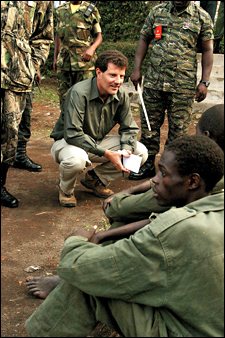#142) CDC I: The Nicholas Kristof Outside Article and Public Health Communications Campaigns
July 18th, 2011
The Centers for Disease Control in Atlanta have some of the boldest, most innovative communications programs and resources in the entire field of science and medicine communication. In a workshop last week we delved deeper into Nicholas Kristof’s powerful 2009 article in Outside Magazine. There’s more wisdom per paragraph in that article than anything I’ve ever read on the mass communication of health issues today. Everyone interested in the subject MUST commit the article’s contents to heart by reading it repeatedly. It’s amazing.
.
NICHOLAS KRISTOF: A one man antidote to the Nerd Loop — someone who has lived and breathed public health communication in Africa like no one else these days.
.
I have talked about the extremely wonderful article published by two time Pulitzer Prize winning NY Times correspondent Nicholas Kristof in November, 2009 in the somewhat unlikely venue of Outside Magazine (it was the subject of the third item I ever posted here on The Benshi). It’s an article that I respect even more each time I reread it.
Last week I took part in another communications workshop at the Centers for Disease Control (my third in the past year). As I reread the article I began feeling like it could almost be my ENTIRE talk by itself. There is SO much wisdom presented, all gained from the years Kristof and his wife have spent working on social and public health issues in Africa. It’s not the theorizing of some professor in the U.S. reading over the literature — it’s the real deal.
Let me just delve into one part that hit home with me during this workshop. The participants were CDC communications staff (and NOBODY in the science and medicine world “gets” communication the way they do at CDC — they are on the front line of connecting with the public because they do PUBLIC health). One woman told me she works in “personal injury” and finds it difficult to get people connected with the subject. It’s not like a disease where it’s an on-going struggle. She asked, “How do you get people to connect with something that’s already happened and they can’t do anything about?” Good question.
But having just read the Kristof article I mentioned the part where he talks about what he’s learned from articles he’s written in the NY Times about the plight of Africans suffering from diseases. He said he began to notice that when he wrote an article about a village being ravaged by a disease, people mostly skipped over it, groaning, “Ugh, bad news, I’ve got enough in my life,” and he got few responses from readers aside from, “What a shame.” But when he told about the people struggling to combat the disease so that villages aren’t destroyed by it the responses would be overwhelming, with people writing in to say, “How can I help these people in their struggle? Where can I send money?”
PEOPLE LIKE TO HEAR A GOOD STORY, BUT WHAT MAKES FOR A GOOD STORY?
After mentioning this to the CDC woman, I went a little further into the subject of storytelling (which was the topic of the workshop). The definition of a good story is “a journey from point A to point B.” The definition of a poor story is “a journey from point A to point A.” Something needs to happen. Things need to change. It is the change that we find interesting.
In the case of talking about a death, the change has already happened. If you tell about a person who was killed in a car wreck from a drunk driver the story isn’t going to change with time — i.e. ten years after it happened the person is still dead. But if you tell about the mother of that person whose life was so completely CHANGED that she started her own local chapter of Mothers Against Drunk Driving and today continues to grow and change — that is a journey of the sort that people love to hear about.
And this is where, believe or not, the creative people of Hollywood are a gigantic resource that ought to be utilized more by organizations trying to communicate. Storytelling is central to broad communication, and NOBODY understands storytelling better than the people of Hollywood. They may be a little flaky or bizarre at times, but why let that get in the way of pursuing the very best resources?
All of which brings me back once again to explain why I continue to be the #1 fan of the Hollywood, Health and Society project, started nearly a decade ago between CDC and the USC Norman Lear Center in the Annenberg School of Communication. If you don’t know what the program is, here’s an interview with it’s longtime Director Sandra deCastro Buffington who is truly a visionary. The project is the best example of people in the applied world (public health) respecting this communication power of Hollywood and putting it to use in a sophisticated way.
There is so much to be learned from what they are doing at the CDC. So tune in later this week when I tell you the most amazing story yet — how the CDC teamed up with zombies to make the world a better place!
.

